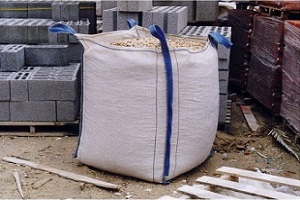Handling FIBC Bags
A flexible Intermediate bulk containers, or a FIBC, is a large fabric container that is generally used to store and transport raw material like sand or plastic pellets. A standard light weight bag often holds up to one metric ton, although they do very in size and strength, depending on the manufacturer. The most common method for transporting these bags is to use the loops to lift them with a crane, or to place them on a pallet and move them with a forklift. Due to the weight these bags can accumulate, as well as the static electricity that they can generate, a number of companies involved in the manufacturing of FIBC’s have come together to form the FIBC Association (FIBCA) in order to educate the end users about the best and safest practices.
Although we have summarized the FIBCA’s “safe handling guidelines” below, we recommend that readers take the time to go through the guidelines and disclaimers in full on their website. All responsibility for using the bags safely falls on individual users and the company they work for so be sure to read all manufacturer recommendations thoroughly.
DO’S:
- Ensure your FIBC is right for your product and for your workspace.
- Reach out to your manufacturer with any questions, including those regarding the usage of the bags.
- Follow all regulations, instructions and requirements provided by the manufacture or supplier of your FIBC.
- Use the manufactures instructions to verify that the loops are attached properly and that the bottom discharge is properly sealed.
- Handle your container with devices that meet the requirements outlined by the FIBCA.
- Use every loop provided to lift the bags, and make sure they’re kept vertical. Slings may be recommended to ensure the verticality of the loops.
- Clear all hazards when transporting.
- Adhere to the height and weight limitations provided.
- Use static protective FIBC’s if handling explosive or flammable materials. Always make sure your bag is grounded to avoid static electricity.
- Allow any charge from static electricity to settle before continuing to handle your FIBC.
- Ensure your bag is up-to-date with all standards outlined by the FIBCA.
- Determine if a liner is appropriate for your type of use, and ensure proper use.
- Stack FIBC bags in a pyramid manner, or with proper support.
- Take notice of any water or moisture contamination that may take place in your work area, effecting FIBC’s and their content.
- Store your container and its liner in a non-static area, if possible.
DONT’S:
- Use a FIBC for any purpose other than its’ intended, capable use.
- Handle a damaged bag without the approval of your manufacturer.
- Use a FIBC without fully understanding the best practices.
- Assume that the bags are in perfect condition, without double-checking.
- Handle a bag with devices that do not comply with the handling guidelines, including those with insufficient capacity.
- Use a single hook or other lifting device that will prevent the loops from staying vertical while lifting occurs.
- Use handling devices that are sharp.
- Suspend a bag over anyone or anything.
- Tilt the mask of a forklift forward while handling a FIBC, or lower/raise the bag while in motion.
- Lift or stop suddenly while transporting.
- Exceed the specified capacity of a FIBC.
- Assume a FIBC has any protective ability holding flammable or explosive material.
- Fill or empty a bag that isn’t grounded.
- Allow the FIBC to block your line of sight, or drag/push it along the ground.
- Use a pallet that has exposed nails, or is smaller than the FIBC.
- Stack FIBC’s on top of each other without proper support.
- Try to repair a damaged container with others on top.
- Store your bags exposed outdoors. Sunlight, UAV rays, rain, snow and other weather conditions may also weaken FIBC’s.
- Assume that a FIBC has a shelf-life of any kind




